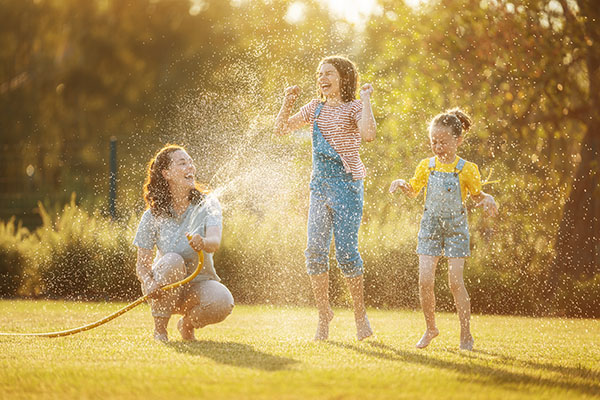Parenting and Empathy By Katharine Manning
Covid. School shootings. Global violence. A racial reckoning. Environmental disasters. Political polarization. Social media pressures. It’s not an easy time to be a child.
It’s not an easy time to parent, either, as we attempt to navigate all of these challenges, as well as rapidly-changing norms, the technology we can never seem to get ahead of, and the mental health crisis.
We can’t change the world. But we can change each moment—by teaching our kids compassion, for others as well as for themselves.
This summer, let’s take a moment to focus on grace. Kindness. Empathy. Let’s teach our kids that caring for others and for ourselves matters, and let’s model that ourselves. Let’s slow down and make time.
And who knows? Maybe that is how we change the world.
Listen. Listen. Listen.
We’re so used to fixing things for our kids—let me tie your shoes, I’ll get your lunch together, you’ll need to study every day this week for that spelling bee on Friday. When a child comes to us in pain or distress or injury, of course we immediately want to take that away. This means we often turn to problem-solving or reframing. Problem-solving: You didn’t do well on your math test? Contact the teacher and see if you can take a retest, and we’ll study together for it. Reframing: Your friend is moving away? Oh, but aren’t you lucky that you have this other new friend you made who’s so great?
I interviewed the grief therapist Meghan Riordan Jarvis (You can read it here), and she warned about “Oh, but.” “Oh, but” is a minimizer. “Oh, but” is “Don’t have those feelings.”
Instead, she urges us toward curiosity and exploration. Some helpful questions are “How does that feel?” and “Tell me more about that.” Once the child has shared how they feel, resist the urge to jump to offering solutions or reframing. Instead, try “that makes sense,” or “I get that,” or “I’m sorry, that sounds hard.” Jarvis also checks in with her kids to give them space to open up: “How are your feelings? Is there anything above a five I should know about?”
Reading or watching shows together can help, too. My daughter and I watched the series This is Us, and I was amazed at the many conversations it spawned on relationships, the choices people make, how they manage their emotions, and how they care for themselves and others. The movie Inside Out and its recent sequel are another fantastic jumping off point for conversations about our feelings and how to manage them.
Build Connection
One of the factors exacerbating the mental health challenges our young people are facing is the increase in isolation. For those ages 15-24, time spent socially with friends decreased 70% in less than two decades (Download PDF HERE). Loneliness among adolescents, which had remained constant prior to 2012, doubled from 2012 to 2018. (Read Story HERE) Note that these studies were conducted before Covid.
This doesn’t mean we need to set up a million playdates or enroll them in dozens of activities. Instead, just help build some small connections. Point out the kid wearing the same shoes your kid is wearing, or the kid who’s also trying to master a somersault in the pool. Start a conversation yourself with the kid who’s wearing a shirt with a character your child loves, and invite your kid into it.
When we discover something in common with someone else, we have a foundation on which to build a more meaningful connection. These connections build empathy and inclusion, and they make us feel less alone.
Volunteering is another great way to give your child a glimpse of the world outside their own bedroom and help them to connect with others. Look for opportunities in particular that allow your child to help someone else—a younger child, for instance, or a pet. Even caring for a plant or a garden can show the benefits of helping others.
Finally, point out to your child when you see them behaving kindly, and note in particular that they are generally kind, helpful, and compassionate. For example, “I saw you talking to Reese when he fell and got hurt. I love that you always help people when they need it.” This helps your child develop a moral identity as the type of person who generally helps others.
Model Self-Compassion
Remember that they absorb what you do far more than what you say. I spoke with a friend recently who wondered aloud why her daughter was so hard on herself. “I always tell her I’m proud of her, and I don’t make a big deal of mistakes. I just can’t figure out why she’s always criticizing herself.” “I don’t think it’s about what you say to her,” I said. “I think it’s more about what you say to yourself.”
When we get frustrated with ourselves for starting dinner late, or missing an appointment, or failing to exercise, they’re watching. If we want them to develop resilience and self-care, we have to model that ourselves. Practice it sometime this week. The next time you realize you’ve made a mistake, say in front of your child, “Oh well! Nobody’s perfect” or “I’m doing my best, and that’s good enough.”
This is good for you, too, of course. If we can manage at least to slow the flow of negative thoughts and admonishments coursing through our brains, perhaps we’ll have a bit more patience. More calm. More joy. And doesn’t that sound nice?
Conclusion
Fostering compassion and connection matters, especially now. By teaching kindness, empathy, and self-compassion, we can help our children navigate a tumultuous world. This summer, let’s slow down, listen, and model the grace we wish to see. Encourage meaningful connections and self-care. Show our kids that it’s okay to have feelings and make mistakes. With small, intentional acts of love and understanding, for them and for ourselves, we can shape a generation that values empathy and resilience. Let’s begin now, together. ❦
 About the Author
About the Author
Katharine Manning is the author of The Empathetic Workplace: Five Steps to a Compassionate, Calm, and Confident Response to Trauma on the Job (HarperCollins Leadership 2021) and the President of Blackbird DC. She has worked on issues of trauma and victimization for more than 25 years.
As a Senior Attorney Advisor with the Executive Office for United States Attorneys, for fifteen years Manning guided the Justice Department through its response to victims in cases ranging from terrorism to large-scale financial fraud to child exploitation. Some of the cases she advised on include the Boston Marathon bombing, the Pulse nightclub and South Carolina AME church shootings, the uprising in Charlottesville, the Madoff investment fraud, and the federal case against Larry Nassar, doctor for the U.S. Women’s Olympic Gymnastics team.
Manning now uses her expertise to help organizations prepare for and respond to the challenges they face involving employees and clients who may be in trauma. A member of the bar in Washington, D.C. and California, Manning also served as an attorney with the law firm Pillsbury Winthrop in San Francisco, where she represented Fortune 500 companies in class actions, insurance, and media cases. She is a graduate of Smith College and the University of Virginia School of Law and teaches at American University and in the Master’s in Trauma-Informed Leadership Program at Dominican University
